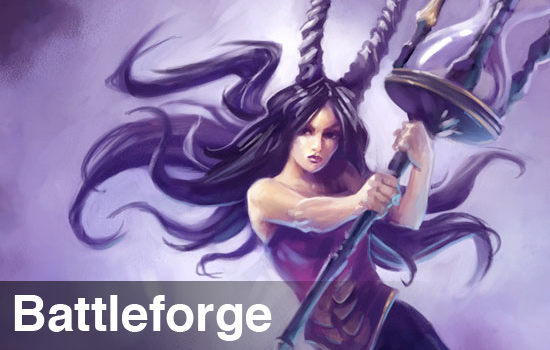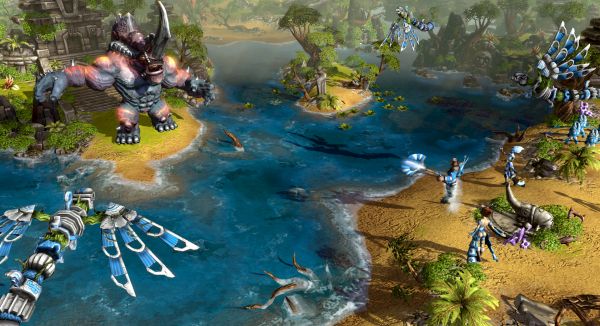

What do you get when you cross an RTS and a collectible card game like Magic: The Gathering, then sprinkle in elements of an MMO? If Electronic Arts has anything to say about it, the answer is Battleforge, a game that is both startlingly unique and strangely familiar. As a Skylord, it is your duty to fight off various threats to the lands of Nyn, encountering Twilight creatures, mortal heroes and even other Skylords along the way.
The twist that Battleforge introduces to the standard RTS model is its card-based system. Instead of teching up during play, the number of resources you allocate to each elemental color of the game determines which cards in the deck you carry into battle are playable. With the exception of a few cards, there are no build times to deal with, and everything is available the instant you play a card. If you are within a certain distance of a friendly resource node, any unit played will appear with its full strength and abilities intact. However, if you are in battle and decide you need to reinforce yourself instantly, you may play a card to summon friendly units to whatever skirmish you may be in. The catch is that any card played into such a situation suffers from “summoning sickness” (can you tell the developers played Magic?), which causes it to appear at 50% health and any triggerable abilities on cooldown.

Balancing what cards you use and when is the core strategic element in Battleforge. In addition to the units available, you may cast spells or build towers and traps, both of which are subject to the same conditions unit cards suffer. If you are being swarmed by small units in battle, a player with a deck built around the fire element might cast the Lava Field spell, which will do a massive amount of damage to small and medium-sized units in a large radius. Using these spells effectively is definitely the key to success, a lesson which you will learn early and often. Victory in battle will afford you upgrades to cards in your deck, allowing you to play more of a given card before your stock is emptied or even upgrading its stats and abilities. A convenient “battle forge” serves as the game’s main UI (and gives the game its title, natch), where you may play any card you want to test out against any combination of enemy mobs or other cards. Anyone getting the hang of the game will find this feature a needed and invaluable addition.
Battleforge may be played by solo players, groups of two, four and even twelve in mission paths designed specifically for each group size. Played cooperatively, each player will be given specific objectives to meet on each map before the final encounter may be attempted. In one early two-player map, each Skylord is tasked with clearing a path to teleporters on their own side of the map, which allows you to meet each other at a friendly NPC’s camp. Once you’re at the camp, each player needs to keep a set of defenders at the North end to fend off waves of hostiles with your NPC’s death in mind, and muster an attack force to clear several camps to the South. Other maps have you racing as fast as you can across the map to protect multiple camps from enemy attacks, ping-ponging back and forth with your co-op teammate in defending your base and attacking a camp that is only accessible to one player every couple minutes, or even drawing a massive foe’s army away from him so your partner can move in for a quick kill. Objectives such as these can be challenging, but strong players will be able to cover for their teammates by sending over reinforcements or healing.
As with most games built around systems such as this, co-op is where Battleforge shines. Since you play on a server with every other player in the world, you may use Battle.net-esque chat channels, friend lists, or even set up a co-op session that is advertised to every player looking for missions in their own UI. As you play through the game, the world map that serves as your mission selector will indicate if there is an open co-op group for any given mission in the world. Unfortunately, there is no way that I discovered to play with a bot partner, so you will definitely want to make friends.
For those with more destructive intentions, there is a full PVP system which allows players to fight against each other with their constructed decks, or even a “sealed deck” game, where each participant buys a stock of brand new cards and may only use those to play against each other.
Yes, I said “buy”, and that is where this game goes from a solid recommendation to a warning to any potential purchaser. As this is a collectible card game as well as a videogame, there is a system of microtransactions in place for you to buy booster packs (around $2.50 per pack of eight randomized cards) and “tomes” (six boosters for the price of five). Anyone wanting to really dig into the customizability of this game is naturally going to want to have all of the potential assets it provides at their disposal, and though the game gives you a generous amount of credit towards booster/tome purchases (around $30, which will get you plenty of new toys to play with), having to pay for new cards can be an off-putting task.
It’s possible to game the system a bit. If you’re lucky enough to land a lot of rare/ultra rare cards (each booster guarantees one rare, and that card has a 20% chance of being an ultra-rare instead) in elements you’re not playing, you can use the auction/trade system to fill in the gaps. Auctions use a combination of gold earned during play to place the auction, and real money (Battleforge Points, which can be purchased at the game’s website) to bid. Auction enough cards you don’t want, and you can use the spoils to purchase more cards. The system is good, but since you have access to every player in your server, a rare card in-game isn’t necessarily as hard to come by as a rare card from a physical CCG. What this means for auction prices down the road is unknown, but serious players will probably need to prep themselves to lay down some hard-earned scratch.
Microtransaction warnings aside, keep in mind that you are never required to buy anything but the game itself (don’t forget to use your $30!). As a cooperative experience, it is a great deal of fun, and with its wealth of unique scenarios, I would recommend it to anyone who enjoys a good casual RTS.